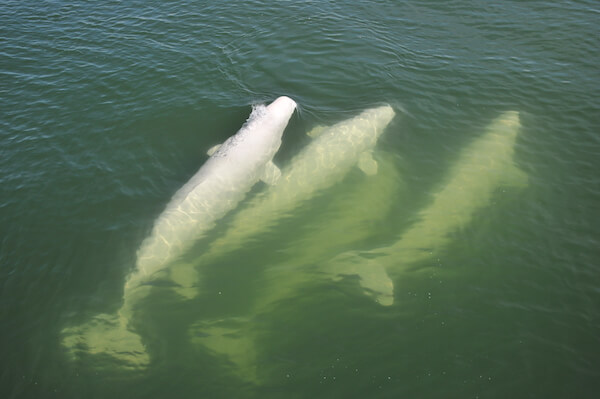Underwater noise is a major issue in the protection St. Lawrence belugas, which rely on sound to find their way, feed, reproduce and socialize. As has been long known, these belugas live in a very hectic area in terms of maritime traffic and are particularly affected by noise pollution. It is now understood that they are not all equal when it comes to this risk.
The use of a new simulation system developed by the team of Clément Chion, a professor at the Université du Québec en Outaouais and researcher at the Institute of Temperate Forest Sciences (ISFORT), is based on beluga behavioural data and demonstrates how individual impact may be underestimated. This model also brings to light the increased vulnerability of females and calves that have to contend with an uptick in maritime traffic.
Changing models
How do researchers determine belugas’ exposure level to noise pollution caused by maritime traffic? There are several methods. Conventional, habitat-oriented approaches consist of overlaying underwater noise maps with animal distribution maps. For simplicity, such approaches will either consider that all whales can go anywhere within their habitat (“spatially mixed” in scientific jargon), or be based on the premise that whales are stationary in this habitat (“spatially static”). However, these two hypotheses are not realistic when we consider how whales really behave, and the choice of hypothesis has a significant impact on the results obtained.
To better model cetacean behaviour, Clément Chion and his colleagues therefore used an “agent”-based model (ABM). In this data-driven computer model, an “agent” is an autonomous entity. With this tool, the researchers will simulate the actions and interactions of individuals and pods in an attempt to best represent the reality of belugas. These behavioural data on how belugas use their habitat come from years of monitoring work carried out by researchers from GREMM and Fisheries and Oceans Canada. Photo-identification in particular establishes where each individual is seen (sometimes on multiple occasions), creating a much more individualized portrait of their behaviour.
Individual impact underestimated
Using this new model to simulate ship and beluga movements, the researchers were able to determine that, over their lifetimes, some belugas were much more exposed to noise than others. However, this individual cumulative exposure goes undetected with conventional modeling methods, which only allow the impact to be assessed at the population and habitat levels. Why is this essential for beluga conservation? By evaluating acoustic impact – current or future – at the population level, researchers run the risk of underestimating noise pollution levels affecting the most exposed individuals. Acoustic impact studies would then be biased and the shipping and boating recommendations issued would be poorly suited.
The Saguenay: An important yet threatened sector
Take the Saguenay Fjord, for example, an important summer area for the St. Lawrence beluga. Individuals are present here almost every day between June and October. In their study, Clément Chion and his team found that belugas that regularly visit the area seem to have less cumulative exposure to noise pollution. This sort of refuge is important for the species, as anthropogenic noise in the Estuary is particularly high.
Unfortunately, projections show that global maritime traffic is expected to surge between now and 2030. Should maritime traffic in the Saguenay River increase, the effect would be magnified. Indeed, the narrowness of the Fjord forces belugas into close contact with passing ships, resulting in very high noise exposure. Any increase in shipping traffic in the Saguenay would therefore quickly lead to higher levels of cumulative noise exposure for belugas frequenting the Fjord, depriving them of a quiet sector within their habitat.
Females and calves particularly at risk
Who exactly uses the Fjord? More than half of all St. Lawrence belugas, and two-thirds of all females! This is the conclusion of the first phase of research by Clément Chion and his team, which was able to show through modelling and behavioural studies that belugas’ use of this area had been underestimated. Females, especially mothers accompanied by their calves, are therefore the most vulnerable individuals as maritime traffic continues to swell. The increase in noise pollution is likely disproportionate for this category of individuals. This risk is all the more serious considering that sound communication is an essential element in the mother-calf relationship.
This finding led researchers in September 2020 to recommend a moratorium on any project that risks increasing maritime traffic in the Saguenay. Recently published findings once again underscore the importance of taking into account the complex behaviours of belugas – both in terms of their social interactions and their movements – when implementing protective measures.







